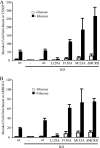Glucose controls nuclear accumulation, promoter binding, and transcriptional activity of the MondoA-Mlx heterodimer
- PMID: 20385767
- PMCID: PMC2876681
- DOI: 10.1128/MCB.01613-09
Glucose controls nuclear accumulation, promoter binding, and transcriptional activity of the MondoA-Mlx heterodimer
Abstract
Maintenance of energy homeostasis is a fundamental requirement for organismal fitness: defective glucose homeostasis underlies numerous metabolic diseases and cancer. At the cellular level, the ability to sense and adapt to changes in intracellular glucose levels is an essential component of this strategy. The basic helix-loop-helix-leucine zipper (bHLHZip) transcription factor complex MondoA-Mlx plays a central role in the transcriptional response to intracellular glucose concentration. MondoA-Mlx complexes accumulate in the nucleus in response to high intracellular glucose concentrations and are required for 75% of glucose-induced transcription. We show here that, rather than simply controlling nuclear accumulation, glucose is required at two additional steps to stimulate the transcription activation function of MondoA-Mlx complexes. Following nuclear accumulation, glucose is required for MondoA-Mlx occupancy at target promoters. Next, glucose stimulates the recruitment of a histone H3 acetyltransferase to promoter-bound MondoA-Mlx to trigger activation of gene expression. Our experiments establish the mechanistic circuitry by which cells sense and respond transcriptionally to various intracellular glucose levels.
Figures







Similar articles
-
Glucose sensing by MondoA:Mlx complexes: a role for hexokinases and direct regulation of thioredoxin-interacting protein expression.Proc Natl Acad Sci U S A. 2008 May 13;105(19):6912-7. doi: 10.1073/pnas.0712199105. Epub 2008 May 5. Proc Natl Acad Sci U S A. 2008. PMID: 18458340 Free PMC article.
-
MondoA-Mlx transcriptional activity is limited by mTOR-MondoA interaction.Mol Cell Biol. 2015 Jan;35(1):101-10. doi: 10.1128/MCB.00636-14. Epub 2014 Oct 20. Mol Cell Biol. 2015. PMID: 25332233 Free PMC article.
-
A novel heterodimerization domain, CRM1, and 14-3-3 control subcellular localization of the MondoA-Mlx heterocomplex.Mol Cell Biol. 2002 Dec;22(24):8514-26. doi: 10.1128/MCB.22.24.8514-8526.2002. Mol Cell Biol. 2002. PMID: 12446771 Free PMC article.
-
Glucose sensing by ChREBP/MondoA-Mlx transcription factors.Semin Cell Dev Biol. 2012 Aug;23(6):640-7. doi: 10.1016/j.semcdb.2012.02.007. Epub 2012 Mar 3. Semin Cell Dev Biol. 2012. PMID: 22406740 Review.
-
The Mlx network: evidence for a parallel Max-like transcriptional network that regulates energy metabolism.Curr Top Microbiol Immunol. 2006;302:255-78. doi: 10.1007/3-540-32952-8_10. Curr Top Microbiol Immunol. 2006. PMID: 16620032 Review.
Cited by
-
MEK1-dependent MondoA phosphorylation regulates glucose uptake in response to ketone bodies in colorectal cancer cells.Cancer Sci. 2023 Mar;114(3):961-975. doi: 10.1111/cas.15667. Epub 2022 Dec 4. Cancer Sci. 2023. PMID: 36398713 Free PMC article.
-
Normal and Neoplastic Growth Suppression by the Extended Myc Network.Cells. 2022 Feb 21;11(4):747. doi: 10.3390/cells11040747. Cells. 2022. PMID: 35203395 Free PMC article. Review.
-
Intracellular Cryptococcus neoformans disrupts the transcriptome profile of M1- and M2-polarized host macrophages.PLoS One. 2020 Aug 28;15(8):e0233818. doi: 10.1371/journal.pone.0233818. eCollection 2020. PLoS One. 2020. PMID: 32857777 Free PMC article.
-
The Regulation of Muscle Structure and Metabolism by Mio/dChREBP in Drosophila.PLoS One. 2015 Aug 25;10(8):e0136504. doi: 10.1371/journal.pone.0136504. eCollection 2015. PLoS One. 2015. PMID: 26305467 Free PMC article.
-
MondoA senses adenine nucleotides: transcriptional induction of thioredoxin-interacting protein.Biochem J. 2013 Jul 15;453(2):209-18. doi: 10.1042/BJ20121126. Biochem J. 2013. PMID: 23631812 Free PMC article.
References
-
- Burgess, S. C., K. Iizuka, N. H. Jeoung, R. A. Harris, Y. Kashiwaya, R. L. Veech, T. Kitazume, and K. Uyeda. 2008. Carbohydrate-response element-binding protein deletion alters substrate utilization producing an energy-deficient liver. J. Biol. Chem. 283:1670-1678. - PubMed
Publication types
MeSH terms
Substances
Grants and funding
LinkOut - more resources
Full Text Sources
Other Literature Sources
Molecular Biology Databases
